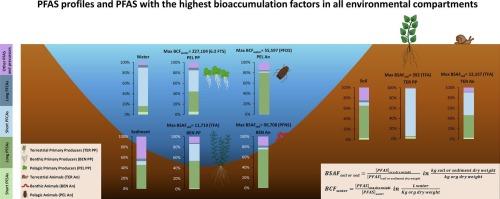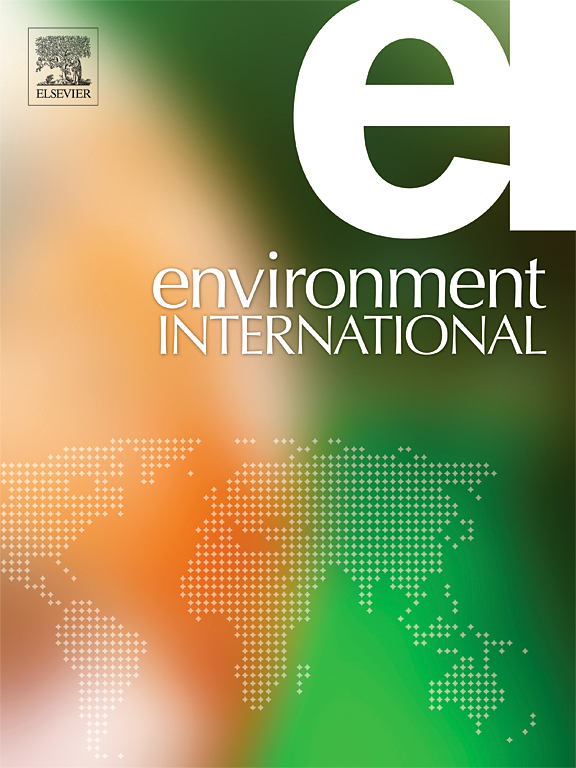各种PFAS在受污染的陆地和水生生态系统中具有很强的生物蓄积性
IF 9.7
1区 环境科学与生态学
Q1 ENVIRONMENTAL SCIENCES
引用次数: 0
摘要
全氟和多氟物质(PFAS)在众多工业和消费应用中的广泛使用,以及它们的持久性和流动性,导致了对非生物和生物环境的全球污染。然而,关于PFAS的发生和生物积累仍然存在重要的知识空白,研究往往集中在水生或陆地生态系统上,对水生环境有偏见。因此,本研究的目的是调查各种PFAS在受污染的陆地和水生生态系统中的分布和生物积累。随后,研究了计算的生物积累因子是否与PFAS分子描述符有关。从PFAS污染生态系统的水生和陆生区室采集了非生物和生物样品,筛选了44种化合物。PFAS以不同的形态和浓度存在于所有环境隔间中。一般来说,水生生物群的浓度高于陆地生物群,动物的浓度高于植物。生物群-土壤和生物群-沉积物累积因子(BSAFs)显示PFAS具有很强的生物累积性,达到96,708 kg沉积物/kg生物群。同样,观察到来自水的高生物浓缩潜力,生物浓缩因子(BCFs)达到55,597 L水/kg生物群。膜-水分配系数(Kmw)在一定程度上解释了PFAS的生物积累,但对PFAS生物积累的驱动因素的了解仍然有限,需要进一步的机理研究。尽管如此,结论是,所分析的44种PFAS中有许多在陆地和水生初级生产者和动物中具有强烈的生物积累,使这些化合物成为未来几十年的重大环境问题。本文章由计算机程序翻译,如有差异,请以英文原文为准。


Strong bioaccumulation of a wide variety of PFAS in a contaminated terrestrial and aquatic ecosystem
The widespread use of Per- and Poly Fluorinated Substances (PFAS) in a multitude of industrial and consumer applications, together with their persistence and mobility, has led to global contamination of the abiotic and biotic environment. Nevertheless, important knowledge gaps remain concerning PFAS occurrence and bioaccumulation, with studies tending to focus either on aquatic or on terrestrial ecosystems, with a bias towards the aquatic environment. The aim of the present study was therefore to investigate the distribution and bioaccumulation of various PFAS in a contaminated terrestrial and aquatic ecosystem. Subsequently, it was examined if the calculated bioaccumulation factors are related to PFAS molecular descriptors. Abiotic and biotic samples were collected from the aquatic and terrestrial compartments of a PFAS contaminated ecosystem and screened for 44 compounds. PFAS were present in all environmental compartments with varying profiles and concentrations. Generally, higher concentrations were found in aquatic than in terrestrial biota as well as in animals compared to plants. Biota-to-soil and biota-to-sediment accumulation factors (BSAFs) demonstrated a strong bioaccumulation of PFAS, reaching 96,708 kg sediment/kg biota. Similarly, a high bioconcentration potential from water was observed, with bioconcentration factors (BCFs) reaching 55,597 L water/kg biota. The membrane-water partition coefficient (Kmw) explained PFAS bioaccumulation to some extent, but the still limited understanding of factors driving PFAS bioaccumulation calls for further mechanistic research. Nonetheless, it is concluded that many of the 44 analyzed PFAS strongly bioaccumulate in terrestrial and aquatic primary producers and animals, making these compounds of great environmental concern for the coming decades.
求助全文
通过发布文献求助,成功后即可免费获取论文全文。
去求助
来源期刊

Environment International
环境科学-环境科学
CiteScore
21.90
自引率
3.40%
发文量
734
审稿时长
2.8 months
期刊介绍:
Environmental Health publishes manuscripts focusing on critical aspects of environmental and occupational medicine, including studies in toxicology and epidemiology, to illuminate the human health implications of exposure to environmental hazards. The journal adopts an open-access model and practices open peer review.
It caters to scientists and practitioners across all environmental science domains, directly or indirectly impacting human health and well-being. With a commitment to enhancing the prevention of environmentally-related health risks, Environmental Health serves as a public health journal for the community and scientists engaged in matters of public health significance concerning the environment.
 求助内容:
求助内容: 应助结果提醒方式:
应助结果提醒方式:


